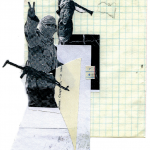By Daryl Meador, Staff Writer
At the Chicago opening of the new film “Miral,” my skepticism was immediately triggered by the movie poster outside the theater. It showed Indian actress Freida Pinto, the star of the film, dressed in a schoolgirl’s outfit and staring up from behind the words, “Is this the face of a terrorist?” It may have been a comment on the dominant assumptions made about Palestinians in American society today, something not often seen in mainstream cinema. But to me, the poster seemed like a shallow approach to that subject, and a manipulative use of Pinto’s natural beauty.
My reaction to the film, directed by Julian Schnabel (the artist behind the infamous broken plate paintings of the 1980s, and director of films like “Before Night Falls” and “The Diving Bell and the Butterfly”) similarly vacillated between skepticism and vague appreciation. Palestinian writer Rula Jebreal wrote the screenplay, adapted from her autobiographical book of the same name. It focuses on the life of Miral (played by Freida Pinto), a Palestinian girl who grew up during the second intifada (or Palestinian uprising) of 2000.
After her mother commits suicide, Miral spends most of her childhood in an East Jerusalem orphanage. As a teenager, she visits the refugee camps of the West Bank, where she witnesses the abrupt devastation caused by an Israeli home demolition. She is then drawn into the populist struggle of the intifada, develops a romantic relationship with a handsome Palestinian underground organizer, and is eventually arrested and brutally tortured by Israeli officials for her involvement in the movement.
Since its release, “Miral” has proven to be controversial on all fronts. Activist groups for Palestine have criticized the film for not delving far enough into the detriment caused by the occupation of Palestine, while it has also been wildly criticized by others, such as the the American Jewish Committee, for its alleged portrayal of Israel in a “highly negative light”.
The film is most successful in its portrayal of the human side of the Palestinian struggle, a point of view often absent in Western media. It contextualizes the violence that isn’t seen by most Americans. A few poignant and touching scenes eloquently speak to the occupation’s destruction of the Palestinian way of life. Early in the film, the orphanage director, Hind Hussein, walks through a field of rubble with an American soldier, who comments on the rocks surrounding them. Hussein tells him that the rocks used to be houses, and what they are walking through used to be a Palestinian village. The house demolition witnessed by Miral was especially touching as well, as it concentrated on the distraught faces of the Palestinian family as they watched their home turn into rubble before their eyes.
But beyond a few touching scenes, the film’s script is just as contrived as the movie poster. The dialogue is simplistic and over-dramatic, coupled with acting that lacks fervor. Most of all, the film falls short of exposing the extent of the damage and misery caused by the Israeli occupation of Palestine. While it is more sympathetic towards the Palestinians than most mainstream movies, it doesn’t fully represent the miserable conditions that drive the Palestinian resistance, as the majority of the film shows Miral’s seemingly comfortable life in East Jerusalem.
And finally, in perhaps its biggest downfall, the film ends with a misleading glorification of the 1993 Oslo Accords, a peace process that eventually failed. Miral’s activist boyfriend experiences a change of heart and tells Miral that he has decided to support the peace talks, saying that he will settle for 22 percent of the land and that the road he had been on was too bloody. Miral asks why the land can’t become one country for everyone, but her comment is dismissed. The film draws to a close as she hopefully awaits the outcome of the peace talks, believing that they will finally bring about an independent Palestinian state.
The film’s conclusion feels especially disappointing after the recent release of the Palestine Papers (thousands of pages of diplomatic correspondence that detailed the inner workings of the Israeli-Palestinian peace process), which revealed that past peace talks often sacrificed the sovereignty and livelihood of the Palestinians. While the film acknowledges that the Oslo Accords never went into effect, it still portrays them as a heroic and potentially viable solution to the conflict.
“Miral” will likely remain a thorn in the side of supporters of Israel, but ironically, it’s also a thorn in the side of America’s grassroots movement for Palestinian rights. As a mainstream movie, however, it does represent a step forward in the balanced portrayal of the Palestinians in Western culture, and will hopefully open a few more people’s eyes to aspects of the conflict that are not readily available in our mainstream culture.






















